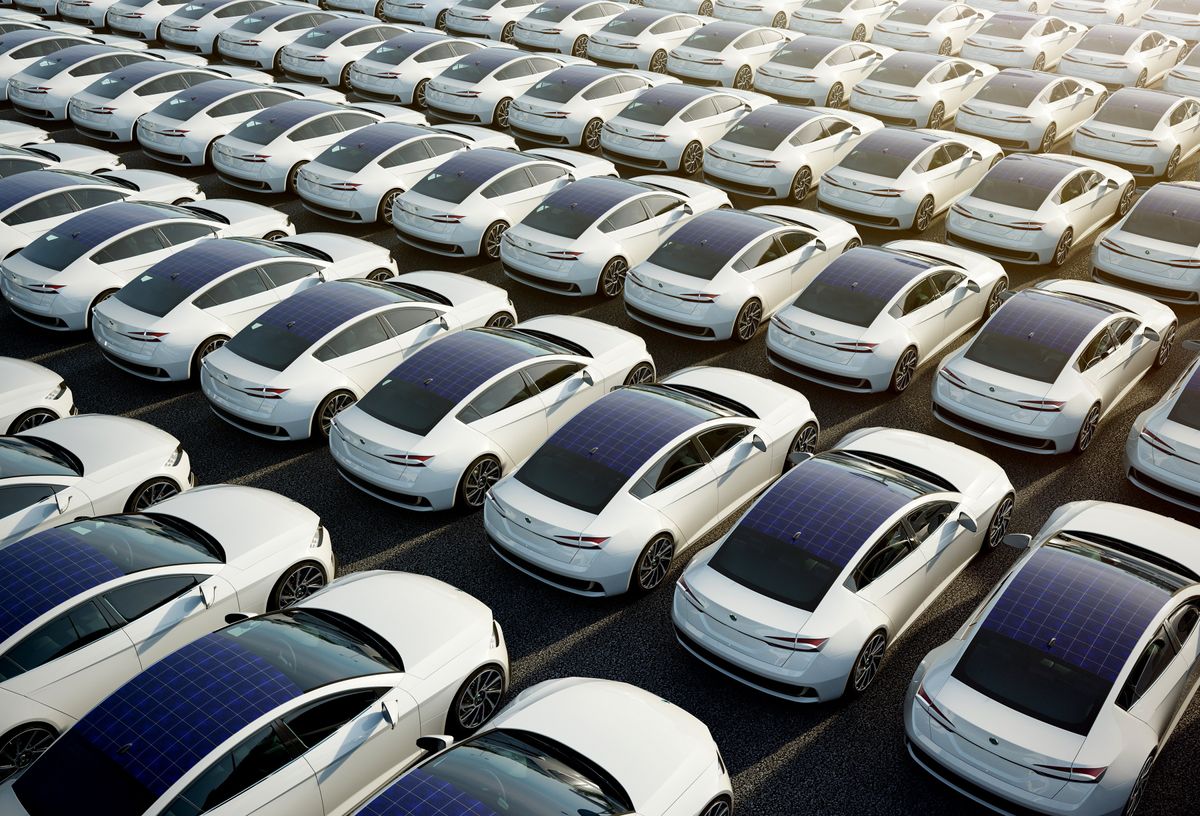This article is part of our exclusive IEEE Journal Watch series in partnership with IEEE Xplore.
If you doubt that a car can absorb a lot of solar power, try sitting in one after it has baked for a while in a parking lot. Whether parked or on the road, our vehicles spend a lot of time in the sunshine. So why don’t more of them harvest power from it?
Ambient solar power absorbed while commuting could potentially provide just enough energy to avoid having to stop to recharge. But so far the idea hasn’t worked out. Toyota has trialed a solar roof as an additional US $600 add-on to the Prius Prime, but the option received lukewarm reviews from testers at MotorTrend. Lightyear and Sono Motors, solar EV companies in Europe, are recovering from bouts of bankruptcy earlier this year.
These are just growing pains, says Miguel Brito, an associate professor at the Dom Luiz Institute in Portugal and an expert on solar-power infrastructure and technology. Completely solar-powered cars aren’t realistic, he says, but EVs that use solar cells to top up their stored energy could be a sweet spot. Such solar-assist technology might ease the stress on the electric grid as more and more vehicles kick their gas habits.
“Instead of charging once a week, on average, you might charge every other week,” he says. “Doing so means that the same infrastructure is able to accommodate something like twice as many cars.”
Solar-assist technology is particularly sensitive to the weight a car must haul around, says Peter Pudney, an associate professor of industrial and applied mathematics at the University of South Australia. He’s sensitive to the matter himself because he serves as the technical committee chair of the Bridgestone World Solar Challenge, which has been challenging engineers since 1987 to design ultralight vehicles to race across the Australian desert on solar power alone. The 2023 competition will take place from 22 through 29 October.
“The PV [photovoltaic] cells used on solar cars are the same as used for rooftop solar panels, [but] because of the limited space available on the roof of a vehicle, cells with the highest available efficiency are normally chosen,” Pudney says. “Instead of focusing on how to increase the energy generated by PV cells on cars, we should be looking at how to decrease the energy required to move people around. Using 1 to 2 tonnes of machinery to move an 80-kilogram person is very inefficient.”
He notes that solar racing cars are a fraction of that weight, at around 150 kg. Other mobility options, like electric bicycles, are even lighter.
Pudney says that designers of solar-powered EVs will also need to consider the shape of the solar cells. Most solar cells are designed as a flat surface in order to collect maximum sunlight, but vehicles are designed with sloped roofs for improved aerodynamics.
Yet, even with these design discrepancies, a 2021 analysis presented at the IEEE 2nd International Conference on Electrical Power and Energy Systems found that simulated EVs could charge their batteries using body-mounted solar panels with 50 percent efficiency.
To investigate just how much sunlight these solar-assisted EVs might get in real-world scenarios, Brito and colleagues published a paper last month in the journal Progress in Photovoltaics to investigate how shadows from tall buildings or city trees might affect these vehicles in urban environments.
In this work, Brito and his colleagues used models of 100 urban environments to simulate the daily shadowing of American-style cities, which are laid out as a grid, and of European-style cities, which expand from a central point. They also equipped buses with solar cells to gather experimental data for comparison. Brito says the team found high levels of agreement between their two datasets and reported that urban shadowing reduced solar-powered driving range by roughly 25 percent.
While this may sound like a lot, Brito remains optimistic about what this means for the rollout of more solar-assisted electric vehicles in the next few years. Paving the way is German solar-EV company Sono Motors, which pivots to selling its tech to legacy car companies.
Solar technology will most likely reach the market as an option in expensive cars, Brito says. “I’d guess in the next four to five years it will become a standard part of electric vehicles and by 2030 all cars will have some sort of solar included in them.”
- World Solar Challenge Results Are Disputed - IEEE Spectrum ›
- Ford's Solar-Powered Hybrid Car Displays Sun-Tracking ... ›
- Solar-Powered Electric Motors for EVs That Never Plug In - IEEE ... ›
Sarah Wells is a science and technology journalist interested in how innovation and research intersect with our daily lives. She has written for a number of national publications, including Popular Mechanics, Popular Science, and Motherboard.



